Influence of a Lighting Column in the Working Width of a W-Beam Barrier on TB51 Crash Test
Abstract
:1. Introduction
- To develop a numerical model of the crash test and its validation for two cases: (1) the test with the barrier and the lighting column and (2) the test with the barrier alone;
- To analyze the results of the crash tests;
- To evaluate the influence of the lighting column on both: the barrier performance and the behavior of the bus.
2. Materials and Methods
- Case No. 1—a simulation with a lighting column;
- Case No. 2—a simulation without a lighting column.
2.1. Full-Scale Experiment
2.2. Numerical Simulation
2.2.1. Road Safety Barrier
2.2.2. Lighting Column
2.2.3. Ground
2.2.4. Vehicle
2.3. Impact Severity Indices
3. Validation of the Numerical Model
3.1. Full-Scale Experiment
3.2. Numerical Simulation
3.3. Damage of the Road Safety Barrier
3.4. Damage of the Vehicle
4. Collisions with and without the Lighting Column
5. Conclusions
Author Contributions
Funding
Institutional Review Board Statement
Informed Consent Statement
Data Availability Statement
Acknowledgments
Conflicts of Interest
References
- European Commission—Press Release. Road Safety in the EU: Fatalities in 2021 Remain Well Below Pre-Pandemic Level; European Commission: Strasbourg, France, 2021. [Google Scholar]
- Budzynski, M.; Jamroz, K.; Wilde, K.; Witkowski, W.; Jelinski, L.; Bruski, D. The role of numerical tests in assessing road restraint system functionality. Eur. Transp. Res. Rev. 2020, 12, 1–12. [Google Scholar] [CrossRef]
- Gaca, S.; Kiec, M. Speed Management for Local and Regional Rural Roads. Transp. Res. Procedia 2016, 14, 4170–4179. [Google Scholar] [CrossRef] [Green Version]
- Tarko, A.; Boyle, L.N.; Montella, A. Emerging research methods and their application to road safety. Accid. Anal. Prev. 2013, 61, 1–2. [Google Scholar] [CrossRef] [PubMed] [Green Version]
- La Torre, F. Forgiving Roadsides Design. In Conference of European Directors of Roads; Technical Report; La Grande Arche: Paris, France, 2012. [Google Scholar]
- Holdridge, J.M.; Shankar, V.N.; Ulfarsson, G.F. The crash severity impacts of fixed roadside objects. J. Saf. Res. 2005, 36, 139–147. [Google Scholar] [CrossRef]
- Pachocki, L.; Daszkiewicz, K.; Łuczkiewicz, P.; Witkowski, W. Biomechanics of Lumbar Spine Injury in Road Barrier Collision—Finite Element Study. Front. Bioeng. Biotechnol. 2021, 9, 760498. [Google Scholar] [CrossRef]
- Zou, Y.; Tarko, A.P. Barrier-relevant crash modification factors and average costs of crashes on arterial roads in Indiana. Accid. Anal. Prev. 2018, 111, 71–85. [Google Scholar] [CrossRef]
- Ambros, J.; Havránek, P.; Valentová, V.; Křivánková, Z.; Striegler, R. Identification of Hazardous Locations in Regional Road Network - Comparison of Reactive and Proactive Approaches. Transp. Res. Procedia 2016, 14, 4209–4217. [Google Scholar] [CrossRef] [Green Version]
- Burbridge, A.; Troutbeck, R. Decompartmentalising road safety barrier stiff ness in the context of vehicle occupant risk. In Proceedings of the Australasian Road Safety Conference, Canberra, Australia, 6–8 September 2016. [Google Scholar]
- Fitzpatrick, C.D.; Harrington, C.P.; Knodler, M.A.; Romoser, M.R. The influence of clear zone size and roadside vegetation on driver behavior. J. Saf. Res. 2014, 49, 97.e1–104.e1. [Google Scholar] [CrossRef]
- Jurewicz, C.; Troutbeck, R.J.; Jurewicz, C.; Troutbeck, R. A Safe System-based approach to selection of clear zones, safety barriers and other roadside treatments. In Proceedings of the Australasian Road Safety Research Policing and Education Conference, Queennsland, Australia, 14–16 October 2012. [Google Scholar]
- Jalayer, M.; Zhou, H. Evaluating the safety risk of roadside features for rural two-lane roads using reliability analysis. Accid. Anal. Prev. 2016, 93, 101–112. [Google Scholar] [CrossRef]
- European Standard EN 1317-1; Road Restraint Systems. Part 1: Terminology and General Criteria for Test Methods. The European Committee for Standardization: Brussels, Belgium, 2010.
- Li, N.; Park, B.B.; Lambert, J.H. Effect of guardrail on reducing fatal and severe injuries on freeways: Real-world crash data analysis and performance assessment. J. Transp. Saf. Secur. 2018, 10, 455–470. [Google Scholar] [CrossRef]
- Mongiardini, M.; Ray, M.H.; Anghileri, M. Acceptance criteria for validation metrics in roadside safety based on repeated full-scale crash tests. Int. J. Reliab. Saf. 2010, 4, 69. [Google Scholar] [CrossRef]
- Atahan, A.O.; Arslan, T. Collision behaviour of double W-beam transition. Int. J. Heavy Veh. Syst. 2012, 19, 76–91. [Google Scholar] [CrossRef]
- Seckinger, N.R.; Roschke, P.N.; Abu-Odeh, A.; Bligh, R.P. Numerical simulation of mow strip subcomponents used with strong post guardrail systems. Int. J. Crashworthiness 2005, 10, 419–427. [Google Scholar] [CrossRef]
- Fang, H.; Wang, Q.; Weggel, D.C. Crash analysis and evaluation of cable median barriers on sloped medians using an efficient finite element model. Adv. Eng. Softw. 2015, 82, 1–13. [Google Scholar] [CrossRef]
- Teng, T.L.; Liang, C.L.; Tran, T.T. Development and validation of a finite element model for road safety barrier impact tests. Simul. Trans. Soc. Model. Simul. Int. 2016, 92, 565–578. [Google Scholar] [CrossRef]
- Sybilski, K.; Małachowski, J. Impact of Disabled Driver’s Mass Center Location on Biomechanical Parameters during Crash. Appl. Sci. 2021, 11, 1417. [Google Scholar] [CrossRef]
- Atahan, A.O.; Arslan, T.; Ganster, W.; Edl, T. Development of a precast slim temporary concrete safety barrier STCSB 50 for work zone applications. J. Transp. Saf. Secur. 2019, 11, 287–304. [Google Scholar] [CrossRef]
- Peng, Y.; Geedipally, S.; Lord, D. Effect of roadside features on single-vehicle roadway departure crashes on rural two-lane roads. Transp. Res. Rec. 2012, 2309, 21–29. [Google Scholar] [CrossRef]
- Bandyopadhyaya, R.; Ujjwal, J. A guideline for assessment of level of service of safety for two lane rural highways using road and roadside features. Adv. Transp. Stud. 2018, 45, 33–42. [Google Scholar]
- Bruski, D.; Burzyński, S.; Chróścielewski, J.; Jamroz, K.; Pachocki, Ł.; Witkowski, W.; Wilde, K. Experimental and numerical analysis of the modified TB32 crash tests of the cable barrier system. Eng. Fail. Anal. 2019, 104, 227–246. [Google Scholar] [CrossRef]
- Uddin, W. Crashworthiness analysis and simulations of vehicles impacting a roadside guardrail. CMES—Comput. Model. Eng. Sci. 2004, 5, 269–278. [Google Scholar]
- Pachocki, Ł.; Bruski, D. Modeling, simulation, and validation of a TB41 crash test of the H2/W5/B concrete vehicle restraint system. Arch. Civ. Mech. Eng. 2020, 20, 1–23. [Google Scholar] [CrossRef]
- Baranowski, P.; Damaziak, K. Numerical simulation of vehicle–lighting pole crash tests: Parametric study of factors influencing predicted occupant safety levels. Materials 2021, 14, 2822. [Google Scholar] [CrossRef]
- Meng, Y.; Hu, W.; Untaroiu, C. An examination of the performance of damaged energy-absorbing end terminals. Accid. Anal. Prev. 2020, 147, 105789. [Google Scholar] [CrossRef] [PubMed]
- Pawlak, M. The Acceleration Severity Index in the impact of a vehicle against permanent road equipment support structures. Mech. Res. Commun. 2016, 77, 21–28. [Google Scholar] [CrossRef]
- La Torre, F.; Domenichini, L.; Meocci, M.; Nocentini, A.; Morano, S.G. Evaluation of the vehicle/safety barrier/sign support interaction by means of FEM simulations. Int. J. Crashworthiness 2015, 20, 123–133. [Google Scholar] [CrossRef]
- European Standard EN 12767; Passive Safety of Support Structures for Road Equipment—Requirements and Test Methods. The European Committee for Standardization: Brussels, Belgium, 2019.
- Research Institute for Protective Systems. Available online: https://eng.ibos.com.pl/ (accessed on 19 May 2022).
- Research Institute for Roads and Bridges. Available online: https://www.ibdim.edu.pl/en/ (accessed on 19 May 2022).
- Wilde, K.; Bruski, D.; Budzyński, M.; Burzyński, S.; Chróścielewski, J.; Jamroz, K.; Pachocki, Ł.; Witkowski, W. Numerical Analysis of TB32 Crash Tests for 4-cable Guardrail Barrier System Installed on the Horizontal Convex Curves of Road. Int. J. Nonlinear Sci. Numer. Simul. 2020, 21, 65–81. [Google Scholar] [CrossRef]
- Klasztorny, M.; Nycz, D.B.; Szurgott, P. Modelling and simulation of crash tests of N2-W4-A category safety road barrier in horizontal concave arc. Int. J. Crashworthiness 2016, 21, 644–659. [Google Scholar] [CrossRef]
- Hallquist, J. LS-DYNA® Theory Manual; LSTC: Livermore, CA, USA, 2006. [Google Scholar]
- Wu, W.; Thomson, R. A study of the interaction between a guardrail post and soil during quasi-static and dynamic loading. Int. J. Impact Eng. 2007, 34, 883–898. [Google Scholar] [CrossRef]
- Budzyński, M.; Jamroz, K.; Jeliński, Ł.; Bruski, D.; Pachocki, Ł.; Baginski, G. Assessing Roadside Hybrid Energy Absorbers Using the Example of SafeEnd. Materials 2022, 15, 1712. [Google Scholar] [CrossRef]
- The Norwegian Public Roads Administration. Available online: https://www.vegvesen.no/en/ (accessed on 19 May 2022).
- Ray, M.; Mongiardini, M.; Plaxico, C.; Anghileri, M. National Cooperative Highway Research Program Project 22–24. Procedures for Verification and Validation of Computer Simulations Used for Roadside Safety Applications; The National Academies Press: Washington, DC, USA, 2011. [Google Scholar]
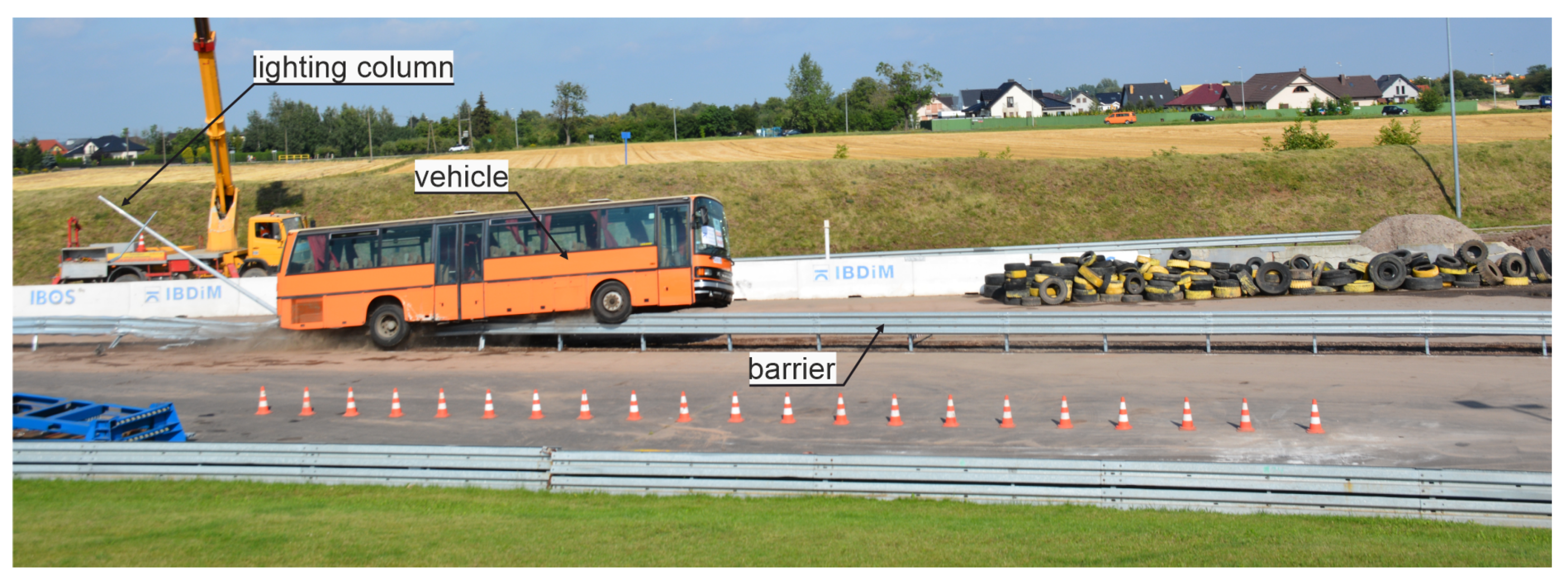
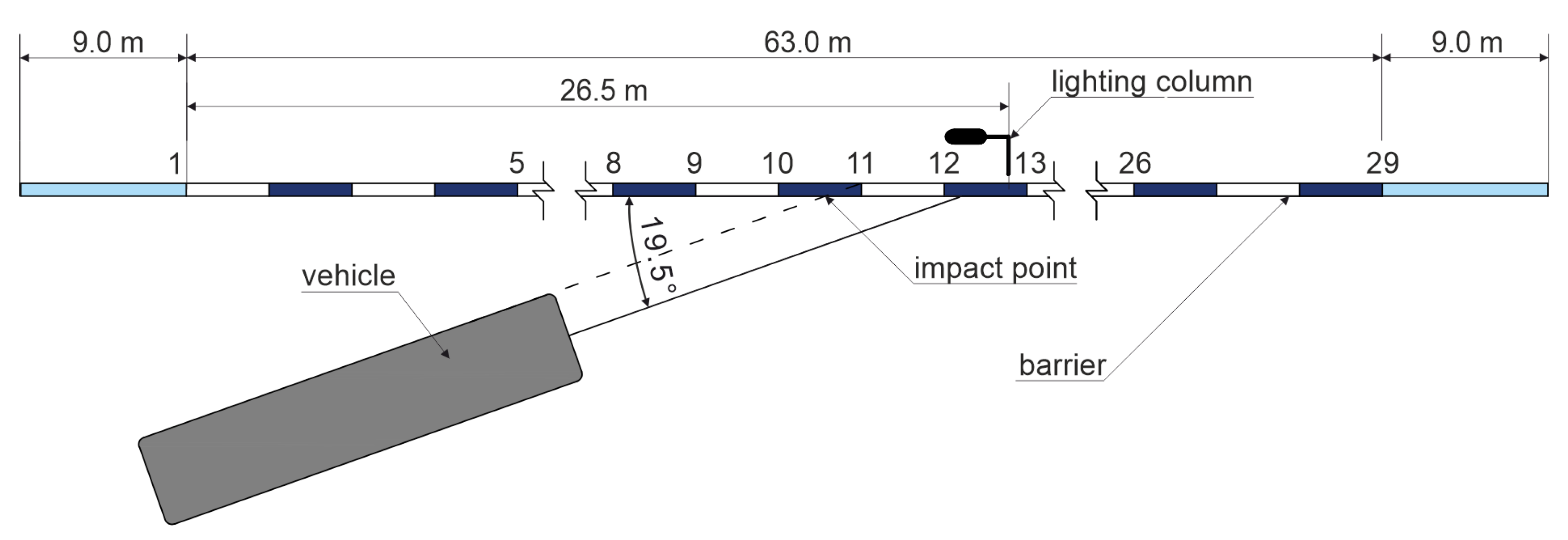
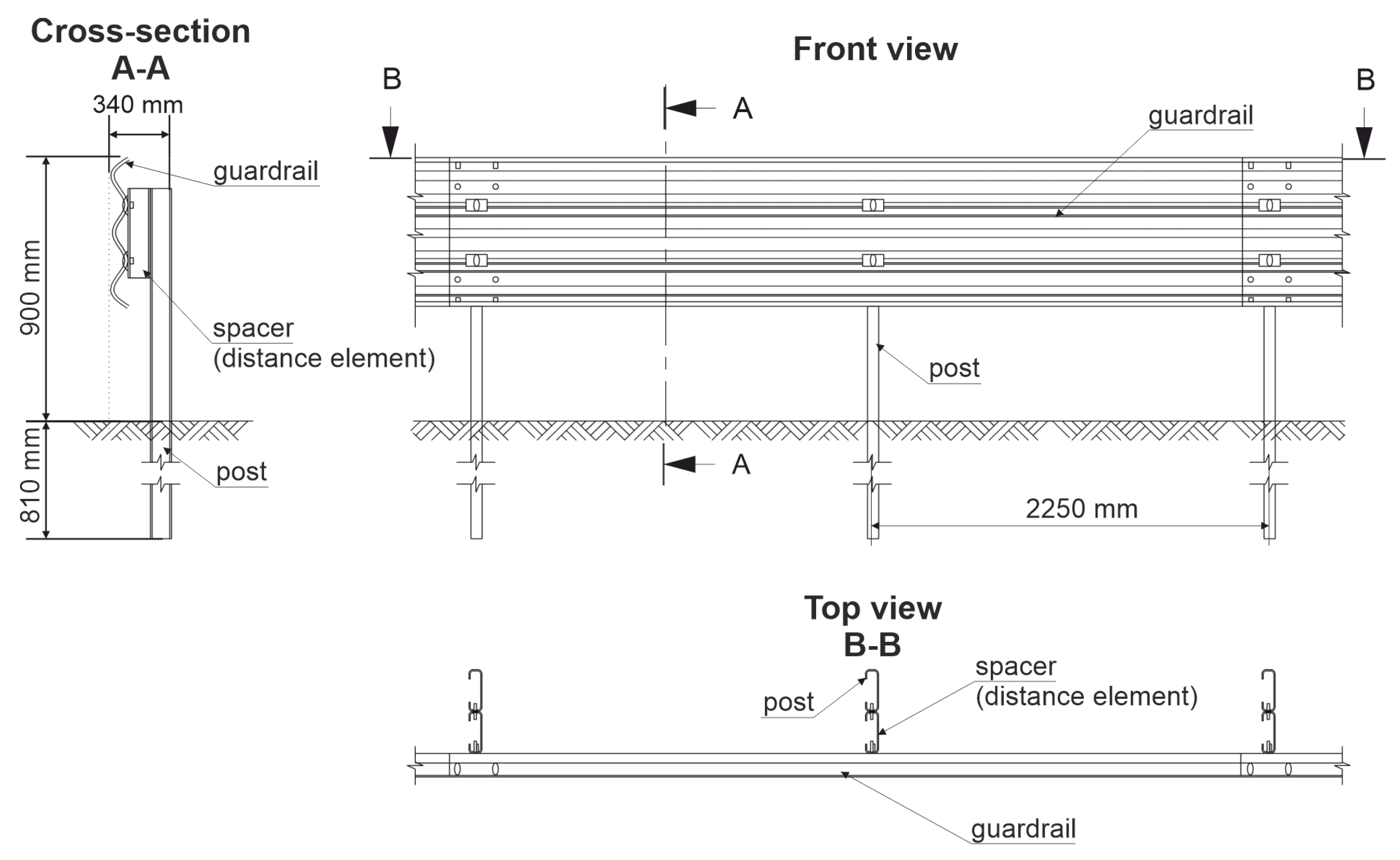
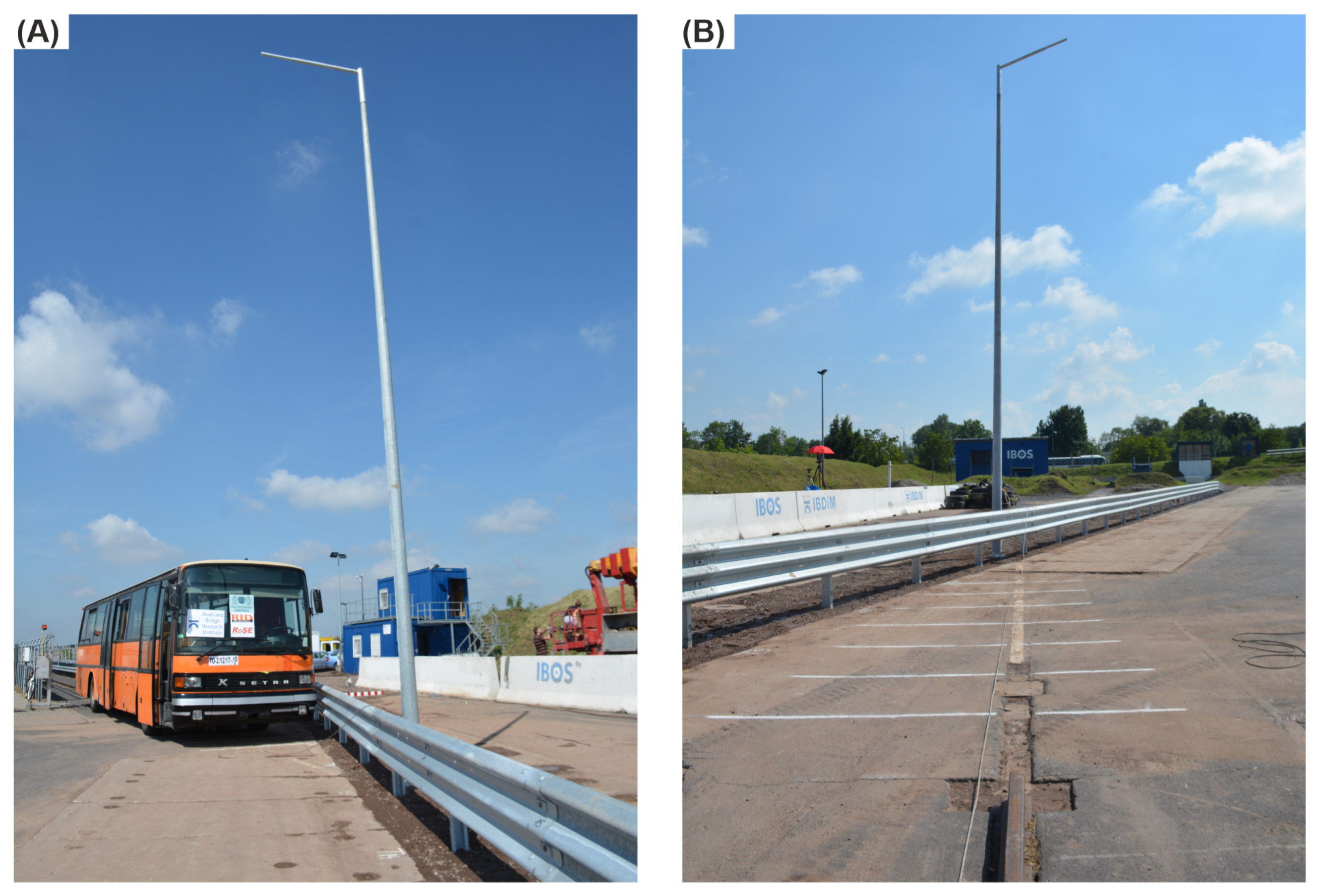
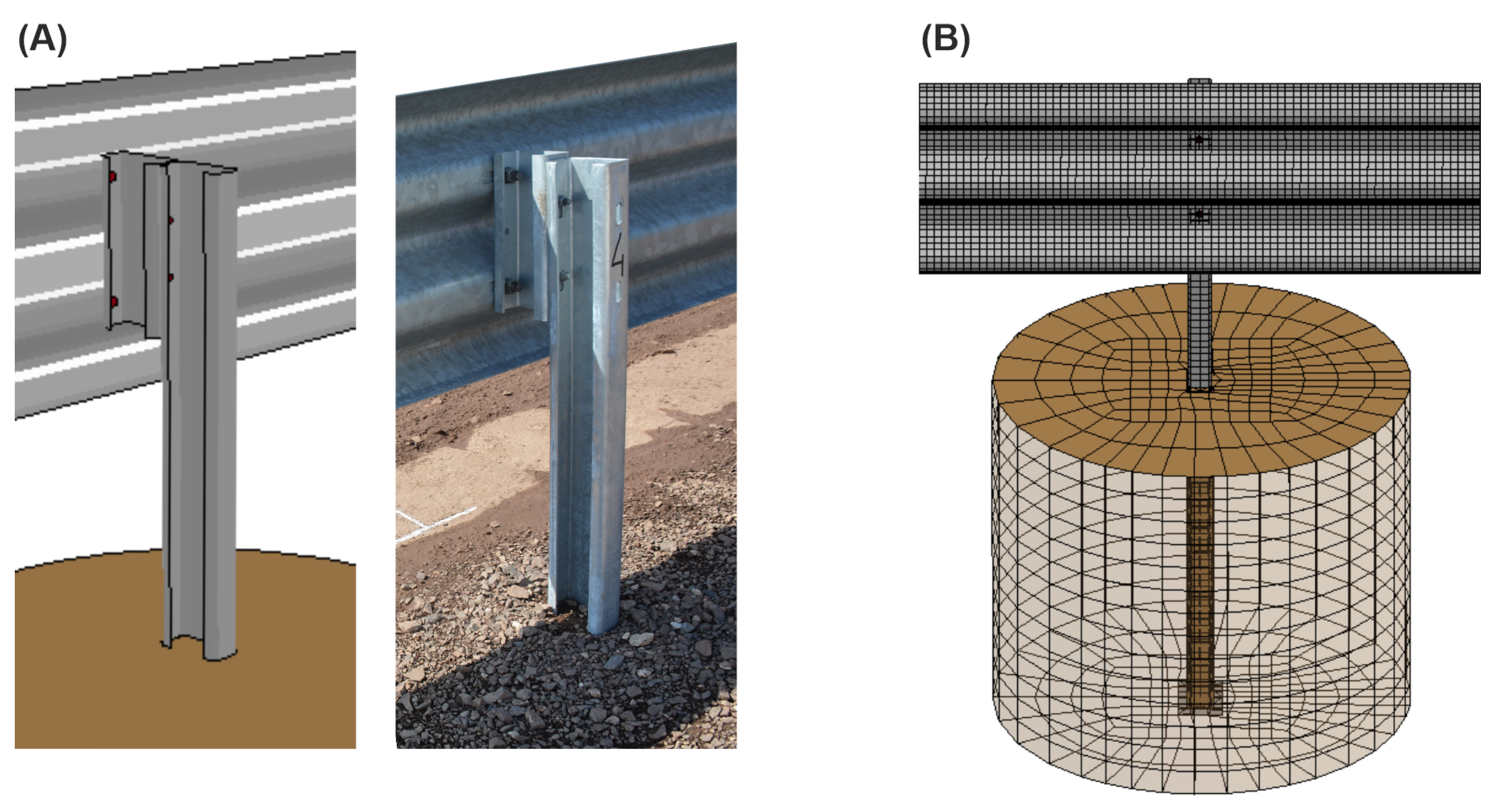
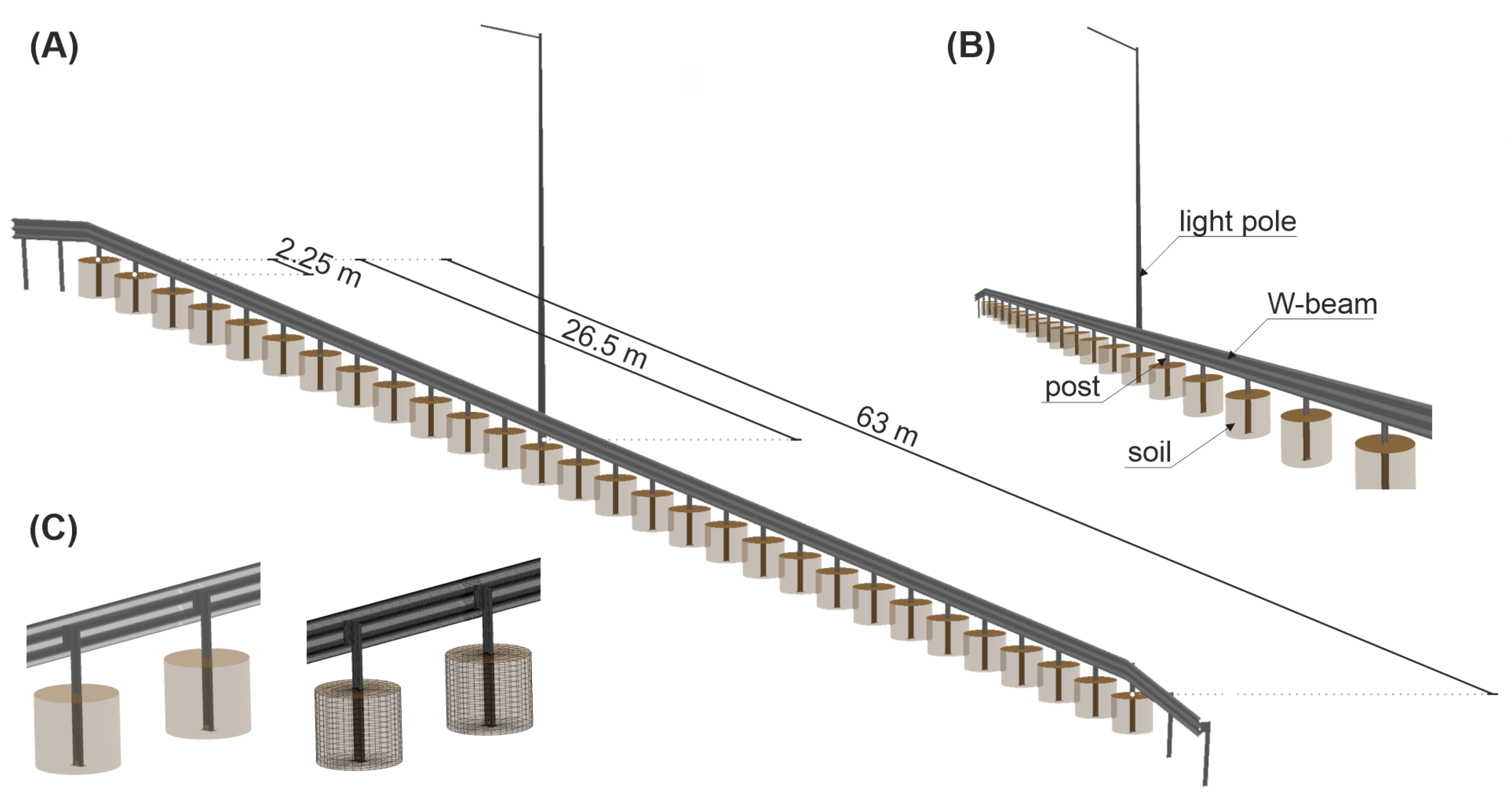




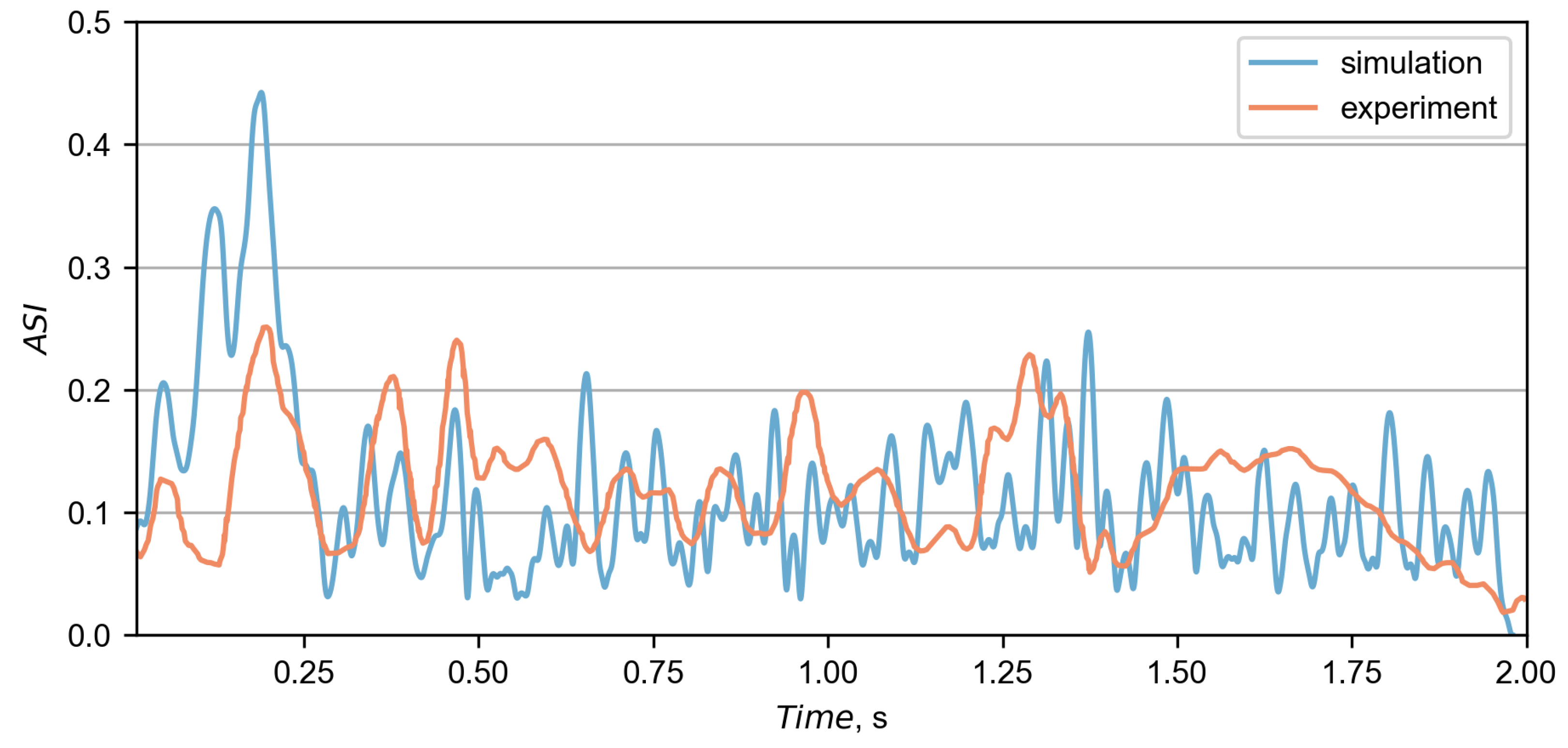
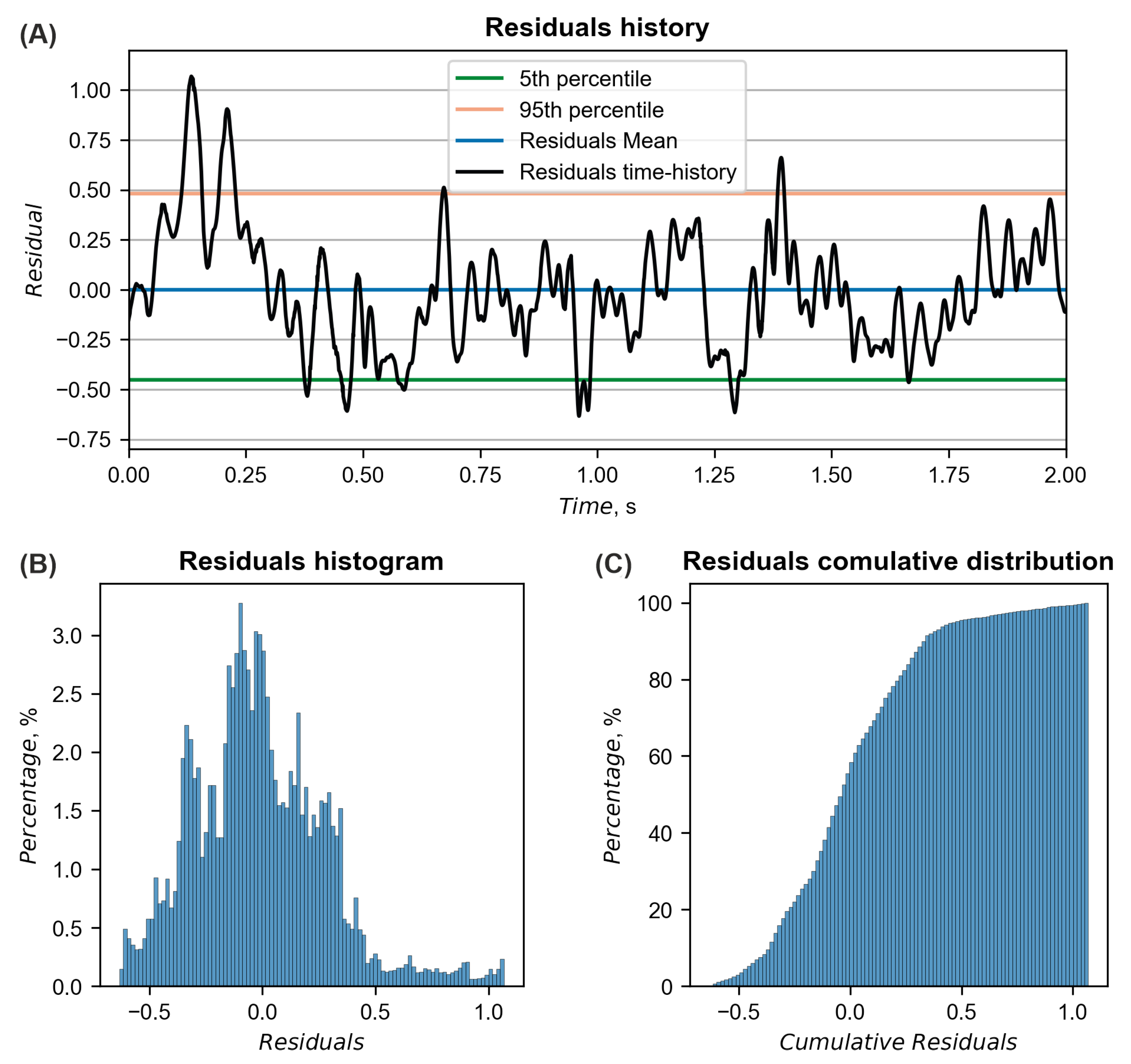
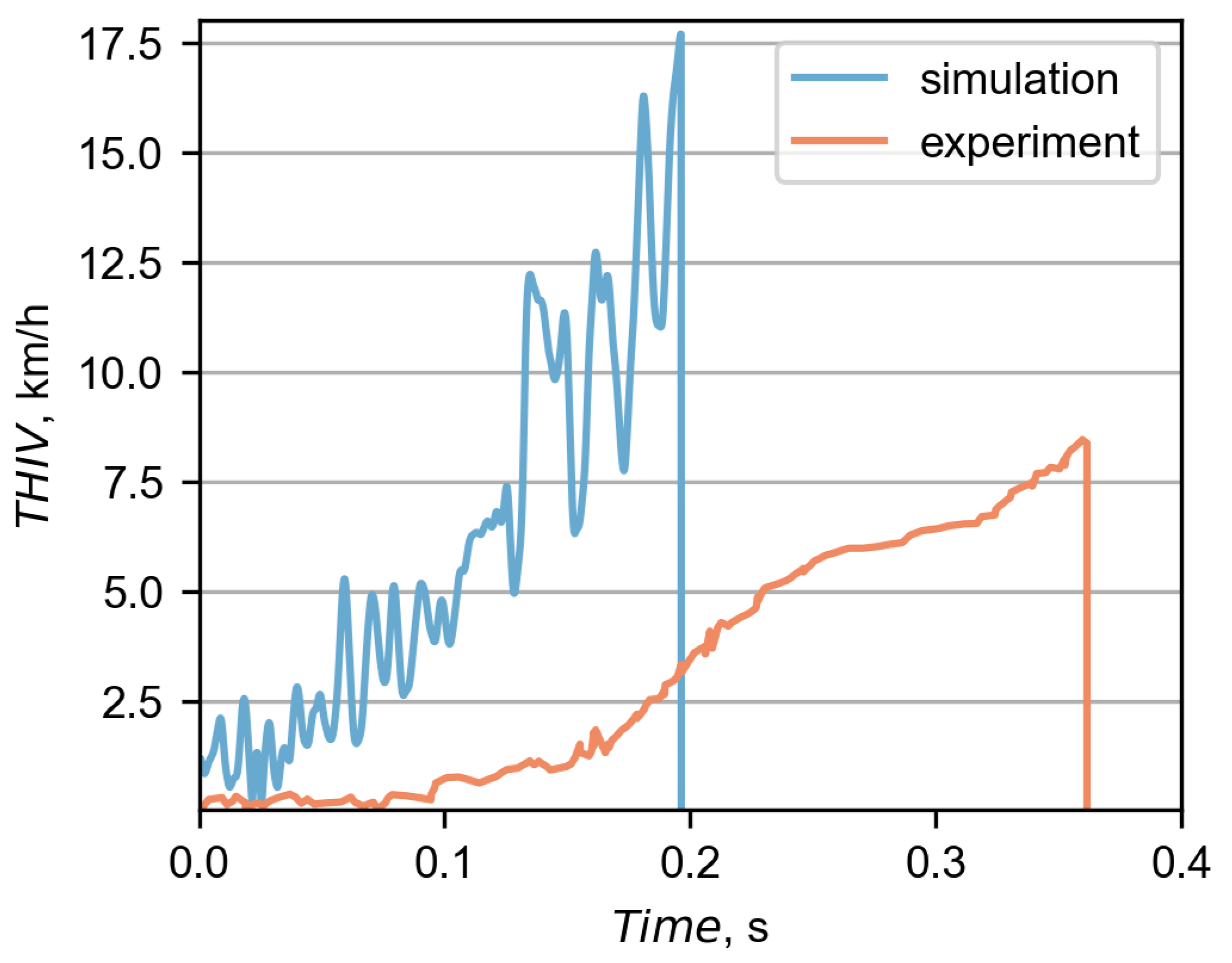
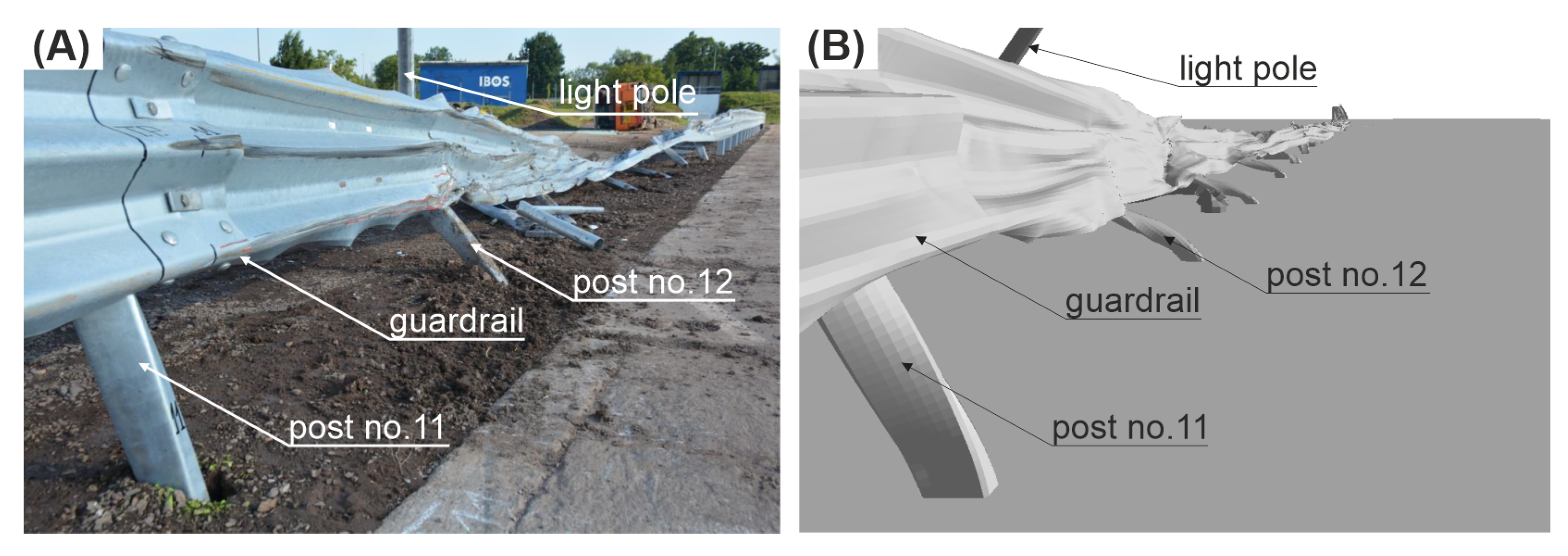
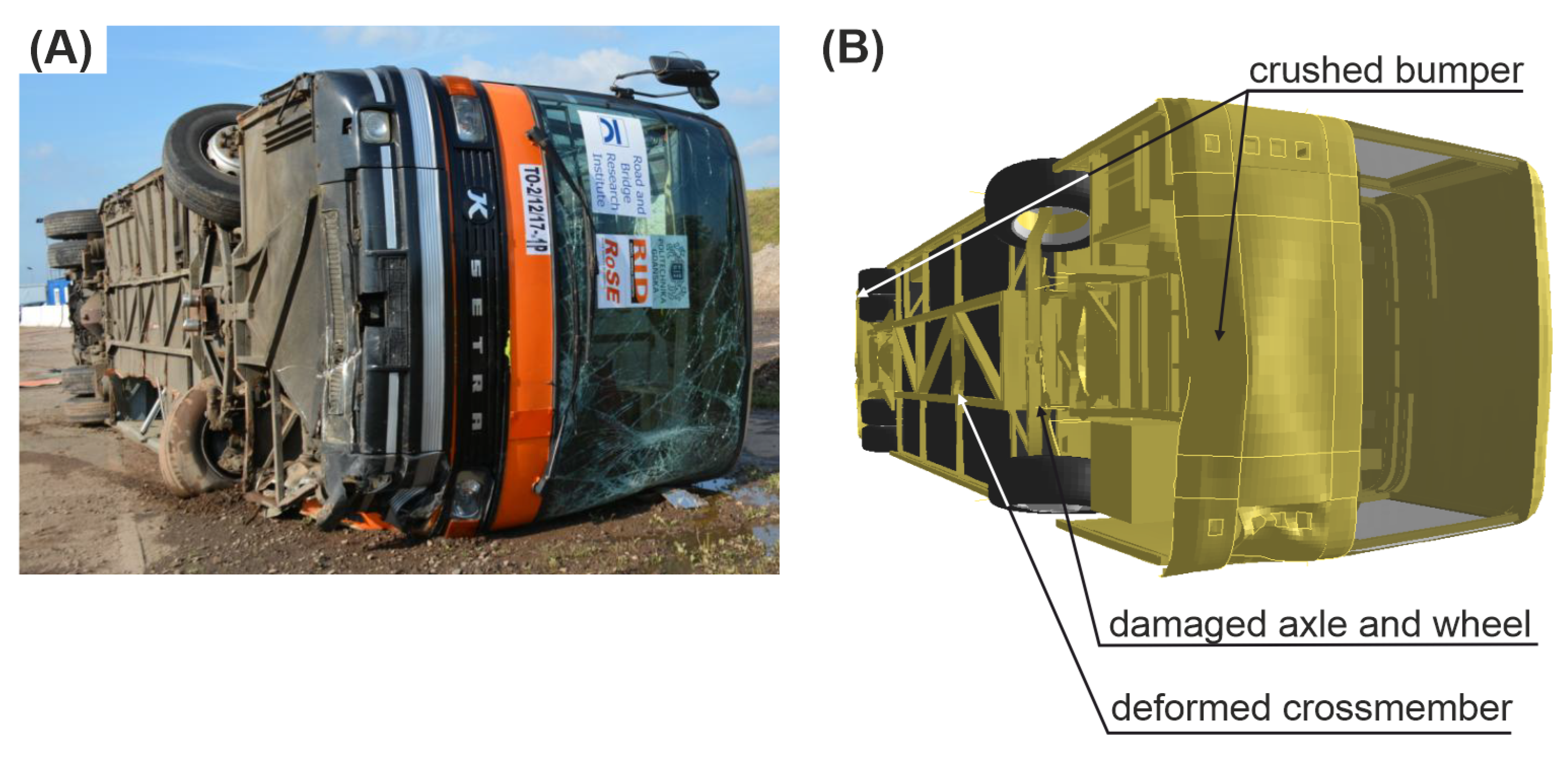
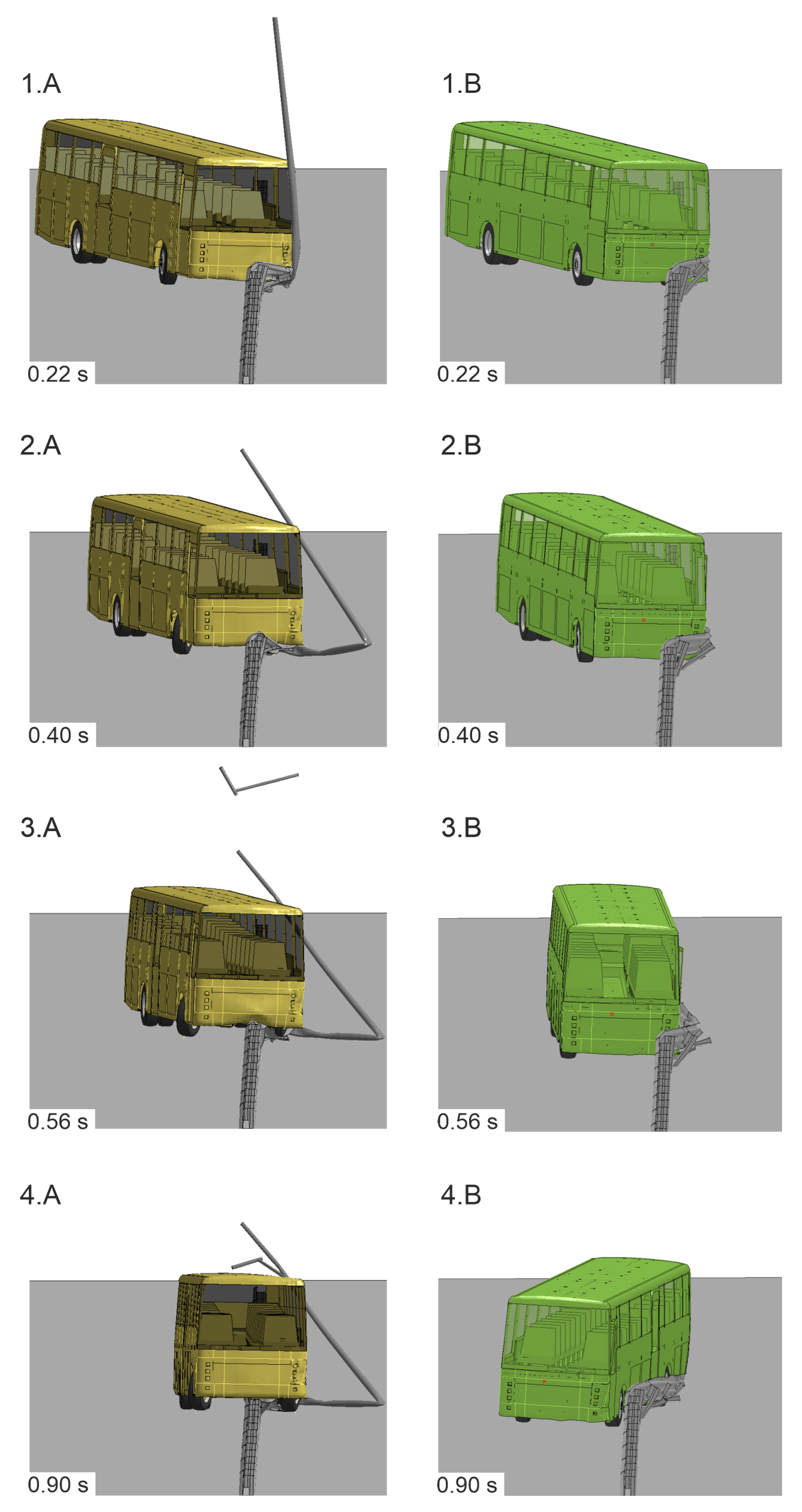
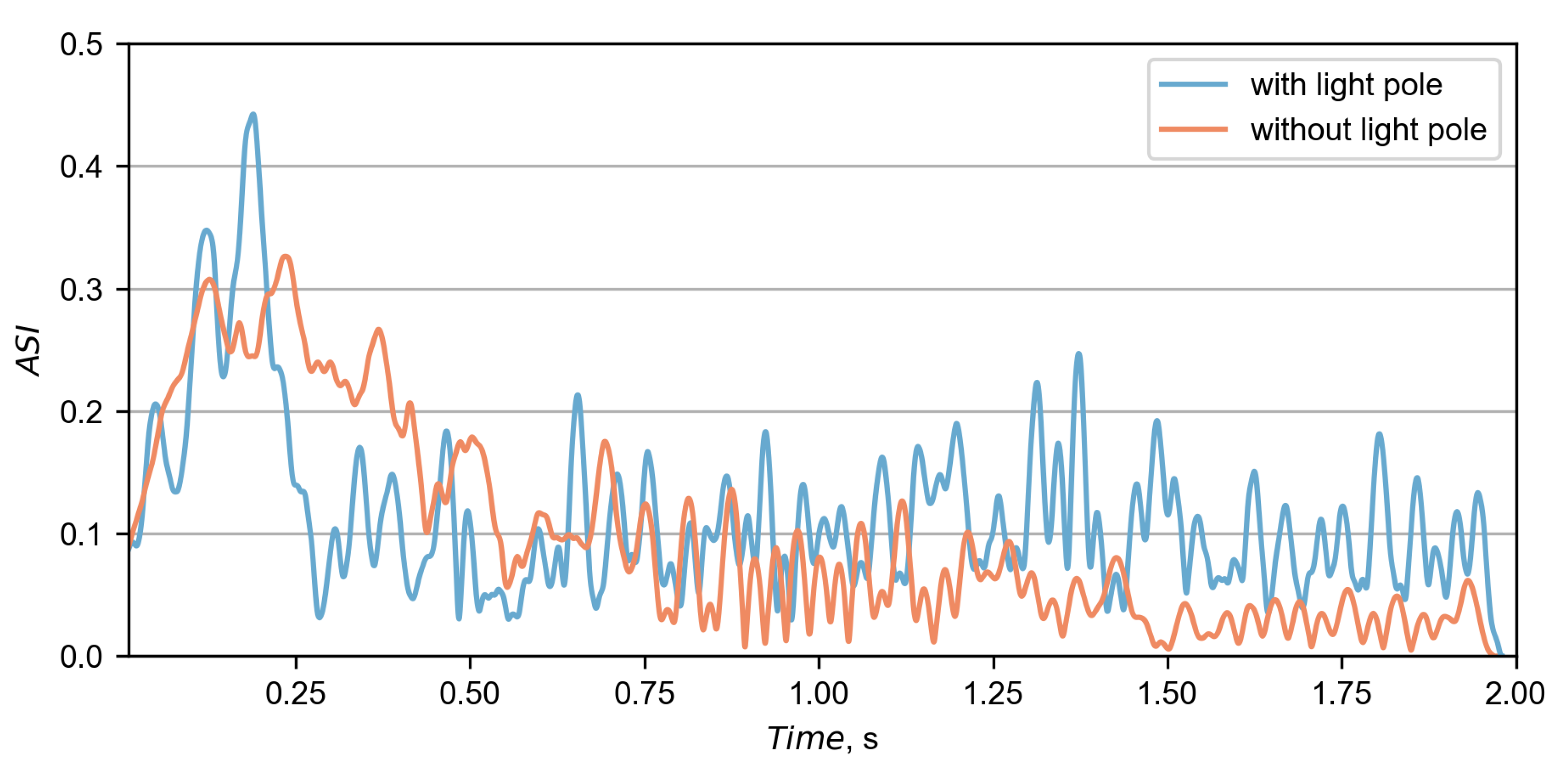
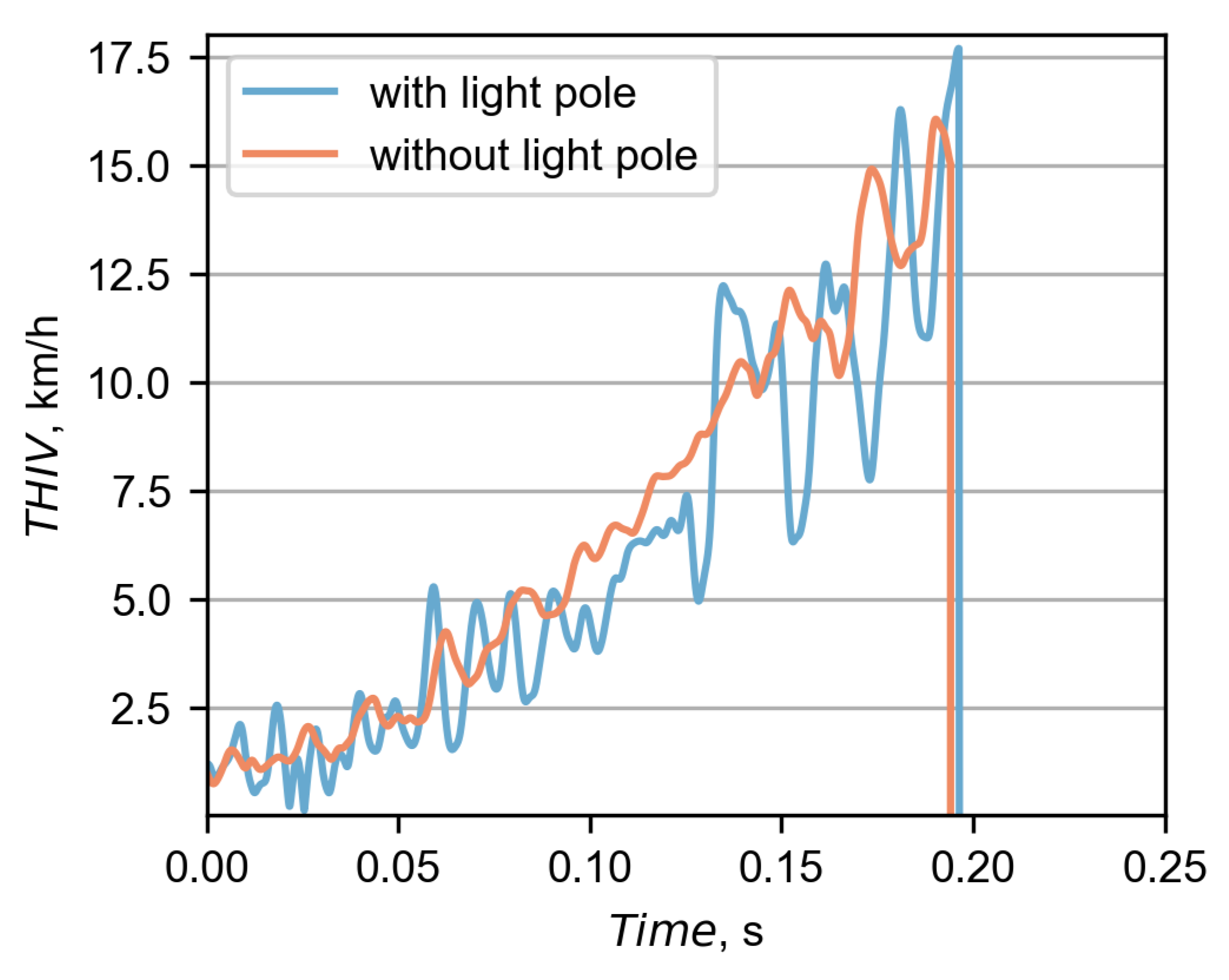
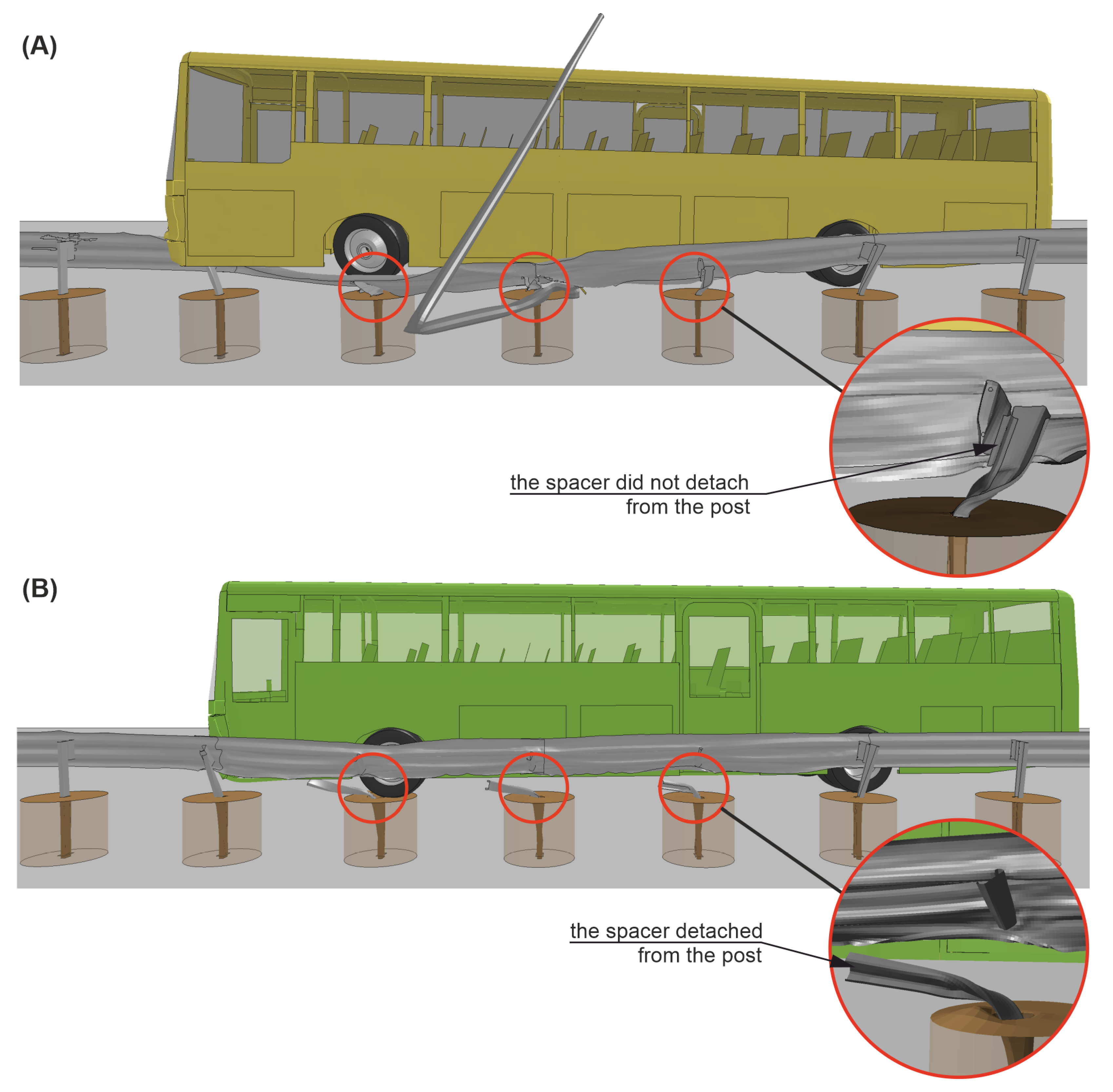
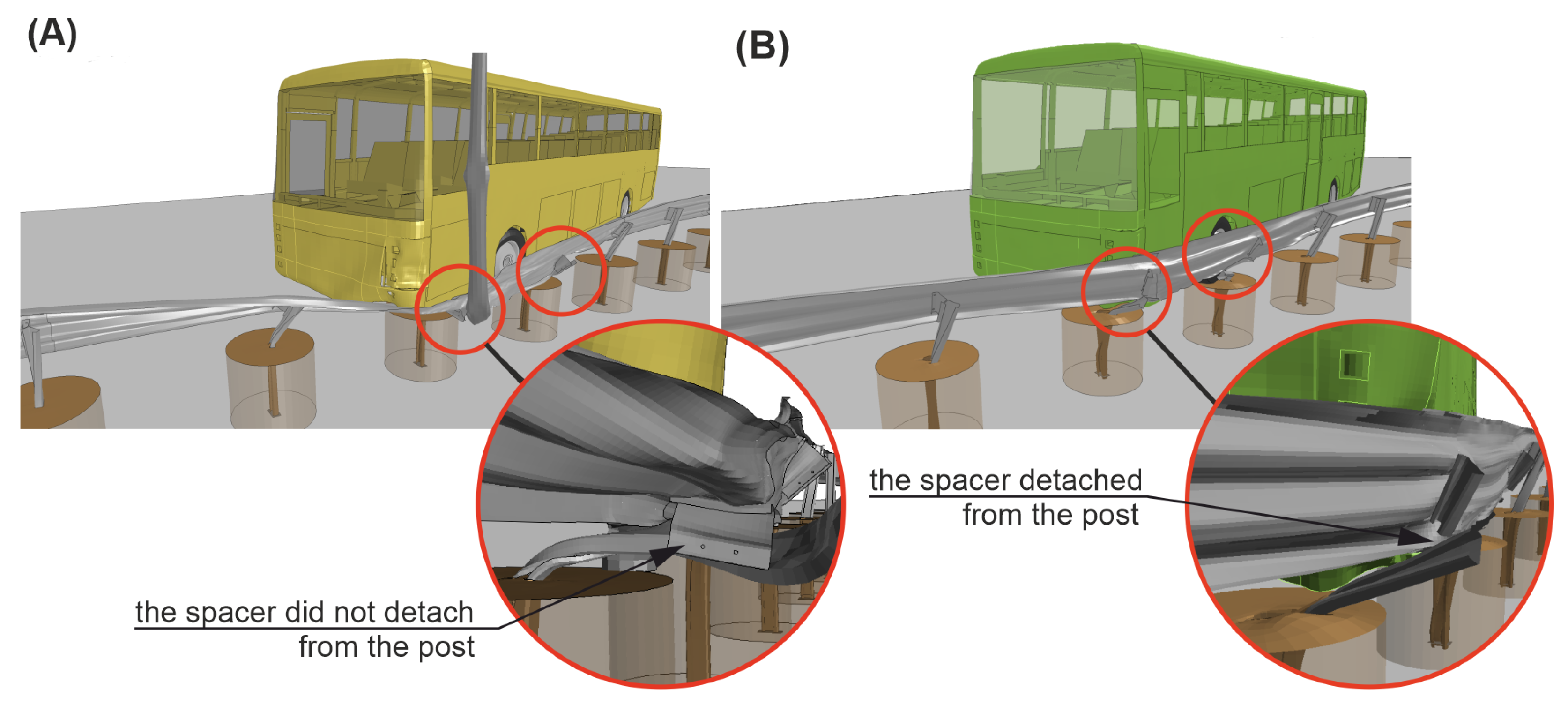

| FE Model | SETRA S215 UL Model Year 1991 | EN 1317 | |
|---|---|---|---|
| Mass | 12,967.6 kg | 12,992 ± 20 kg | 13,000 ± 400 kg |
| Length | 12.80 m | 12.010 ± 0.020 m | n/a |
| Width | 2.506 m | 2.490 ± 0.020 m | n/a |
| Location of center of gravity (CG) | : 3987 mm : 0 mm : 1338 mm | : 3815 ± 2 mm : 3 ± 2 mm : 1435 ± 2 mm | : 3800 mm ± 10% : ±100 mm : 1400 mm / |
| Number of axles | 2 | 2 | n/a |
| Wheel base | 6.798 m | 6.080 ± 0.020 m | 6.50 m ± 15% |
| Wheel track (front/rear) | 2.088 m/1.769 m | 2.070 ± 0.020 m/1.800 ± 0.020 m | 2.00 m ± 15% |
| Wheel radius (front/rear) | 0.495 m/0.495 m | 0.490 ± 0.005 m/0.492 ± 0.005 m | 0.52 m ± 15% |
| Number of nodes | 125,550 | n/a | n/a |
| Number of FEs | 128,245 | n/a | n/a |
| MPC Metrics | Value, % |
|---|---|
| Sprague–Geers Magnitude | 6.3 |
| Sprague–Geers Phase | 18.2 |
| Sprague–Geers Comprehensive | 19.2 |
| ANOVA Metrics | |
| Average | −1 |
| Std | 29.6 |
| Single Value Metrics | |
| Correlation Coefficient | 84.1 |
| Time Intervals, s | Comparison between Simulations | |
|---|---|---|
| Case No 1 | Case No 2 | |
| 0.0 *–0.13 | Similar Course | |
| 0.14–0.25 | The guardrail made contact with the lighting column, which prevented the connection between the post and the guardrail from breaking (see Figure 16(1.A) and Figure 20A). | Post No. 12 was detached from the guardrail (see Figure 16(1.B) and Figure 20B). |
| 0.26–0.39 | Post No. 13 did not detach from the guardrail, and the system was pressed to the ground by the vehicle chassis (see Figure 16(2.A)). | Another post (No. 13) was detached from the guardrail. The guardrail flattened against the vehicle body and began to redirect the vehicle (see Figure 16(2.B)). |
| 0.40–0.63 | After sliding underneath the vehicle chassis, the guardrail was shaped into a flat surface parallel to the ground, which acted as a ramp, which allowed the vehicle to run over the barrier (see Figure 16(3.A)). | Post No. 14 disconnected from the guardrail, and the guardrail continued to effectively redirect the vehicle (see Figure 16(3.B)). |
| 0.63–0.85 | The left-front wheel of the vehicle crossed to the other side of the barrier, and the vehicle chassis landed on the top of the guardrail. The system underneath the bus almost completely laid down on the ground (see Figure 16(4.A) and Figure 19A). | The bus was moving parallel to the line of the barrier. Post No. 12, 13, and 14 were disconnected from the system (see Figure 16(4.B) and Figure 19B). |
| 0.86–1.07 | The left-rear wheel of the bus reached the barrier. | The vehicle continued to move along the guardrail. |
| 1.08–2.0 ** | The left-rear wheel of the bus crossed to the other side of the barrier, and the whole vehicle was over the system. The bus chassis pressed the system to the ground; however, no posts detached from the guardrail. | The bus eventually left the system completely redirected. |
Publisher’s Note: MDPI stays neutral with regard to jurisdictional claims in published maps and institutional affiliations. |
© 2022 by the authors. Licensee MDPI, Basel, Switzerland. This article is an open access article distributed under the terms and conditions of the Creative Commons Attribution (CC BY) license (https://creativecommons.org/licenses/by/4.0/).
Share and Cite
Wolny, R.; Bruski, D.; Budzyński, M.; Pachocki, L.; Wilde, K. Influence of a Lighting Column in the Working Width of a W-Beam Barrier on TB51 Crash Test. Materials 2022, 15, 4926. https://doi.org/10.3390/ma15144926
Wolny R, Bruski D, Budzyński M, Pachocki L, Wilde K. Influence of a Lighting Column in the Working Width of a W-Beam Barrier on TB51 Crash Test. Materials. 2022; 15(14):4926. https://doi.org/10.3390/ma15144926
Chicago/Turabian StyleWolny, Radoslaw, Dawid Bruski, Marcin Budzyński, Lukasz Pachocki, and Krzysztof Wilde. 2022. "Influence of a Lighting Column in the Working Width of a W-Beam Barrier on TB51 Crash Test" Materials 15, no. 14: 4926. https://doi.org/10.3390/ma15144926
APA StyleWolny, R., Bruski, D., Budzyński, M., Pachocki, L., & Wilde, K. (2022). Influence of a Lighting Column in the Working Width of a W-Beam Barrier on TB51 Crash Test. Materials, 15(14), 4926. https://doi.org/10.3390/ma15144926






